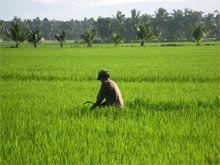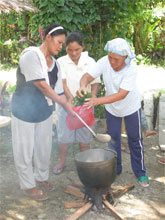
Danilo working in his organic rice field. Danilo made the switch to organic farming for its economic benefits as well as to avoid health problems caused by chemical pesticides.Photo by John Cavanagh.
This article was originally published on the YES! Magazine website.
One of the biggest myths about organic farmers is that they are “unscientific” and “backward.” After time in the southern Philippines with Danilo and Carlito, we learn something quite different.
Danilo is slight in build, with a deep tan and a shy but engaging smile. We stand at the edge of his hectare of neat, nearly mature, green rice stalks, our gaze drawn to Mt. Apo, the Philippines’ largest peak, rising majestically in the southwest. “It is all ‘zero-chem,’ that is to say organic,” Danilo tells us proudly.
It was the simple economics of organic farming that won Danilo over. He calculates that his costs have fallen from about $400 each planting-to-harvest cycle to roughly $160, and that his yields have dipped only a bit. Bottom line: he is making a lot more money each harvest. Every organic farming family we talked to reported lower costs and, as a result, liberation from the debts that haunted their lives. Health is also a key factor: Danilo describes the spells of dizziness that he used to suffer when spraying chemical pesticides before his switch to organic rice.
As we talk, “farmer scientist” Carlito pulls up on his motorcycle, dressed in a white racing jersey and dark glasses. Carlito works for a local citizens group called the Davao Provinces Rural Development Institute (DPRDI) that is helping farmers shift from chemical to organic rice and providing continued support after they do so. Carlito is not a formally trained agricultural scientist; he is largely self-taught and he scoffs at the chemically oriented mindset of the agricultural schools.

Bibing (left) and other women making one of the natural “concoctions” that have replaced chemical fertilizers and pesticides in organic agriculture. All the ingredients can be grown at the farm or purchased at the local market. Photo by Robin Broad.
Danilo is concerned that some of his rice leaves have turned red recently, so he contacted Carlito. They fall into a deep discussion about whether to ignore the red leaves for now or spray them with what they are calling a “concoction.” Carlito is a humble yet animated person, with an easy, joking manner. A farmer himself, he knows that decisions about rice are life and death for farmers, and he treats Danilo with deep respect. In the end, they decide to make the final choice the next day when Carlito will stop by again.
We ask more about what’s in the “concoction” they’re thinking of spraying. Carlito invites us to his barrio where his wife Bibing and her neighbors agree to show us how to make the various natural “concoctions” that have replaced chemical fertilizers and pesticides in organic agriculture. We are, of course, game. At their home, Bibing and three friends feed us lunch. Then, they light a fire under a large pot filled with water, and tell us how they began to make these mixtures. “In 1997, the DPRDI taught us how to make eight different concoctions,” one tells us. “Some are made with fermented fruits, some with vegetables, some with fish bones or egg shells, or with seaweed. Some help prepare the soil; some discourage certain viruses or pests.”
Another woman adds: “All the ingredients are grown here or available at the local market. Each member of our group focused on one of the concoctions, and we sold quite a bit in the first few years.” Bibing laughs with pride as she describes their short-lived financial success: “Then, many farmers learned to make them on their own, and our sales went down.”
As the water starts to boil, Bibing stirs in carefully measured amounts of molasses and then seaweed. The fire is hot and, with sweat rolling off their faces, the women take turns stirring. As Carlito cuts bananas to ferment for another concoction, he explains that the recipes came originally from the innovations of Korean organic farmers. After the designated 45 minutes of cooking and stirring, the seaweed concoction is finished and ready for fermentation in an air-tight container.
The next afternoon, we travel back at Danilo’s rice field to see whether he has chosen to spray. He tells us that he and Carlito have decided that the red stalks are not dangerous at this point in the rice growing cycle. Instead, his nephew is now spraying an aged batch of the seaweed concoction cooked by Bibing’s group to make the rice stalks firmer as they grow heavier.
“The timing of spraying is as important as what to spray,” Danilo explains. At around 5 a.m. and again at 4 p.m. each day, “the vegetation is moist with dew and comes alive with insects.” As we edge into his rice field, Danilo serves as our teacher of the animal life on and around his ripe stalks. In Hollywood, spiders periodically star in horror movies. In Danilo’s rice field, they are friends that eat the larvae of the “bad” stem borers. We discover a batch of bright red snail eggs, but Danilo is not concerned. They are a pest at planting time, he explains, because they eat the young rice shoots; now, close to harvest, they are helping by eating the weeds.
As we jot down the names and descriptions of various bugs and watch Danilo’s nephew spray, it’s clear that organic farming has evolved far beyond simple composting of biomass. It requires a mix of science, math, common sense, and hard work. Unlike chemical farming, with organic farming each day is new adventure of weeding, monitoring insects, making concoctions, and weighing options. To Danilo, this is empowering rather than overwhelming.
Many outsiders believe that the farmers who embrace chemical agriculture are the ones embracing science and progress. But in different farms around the world, we are discovering that the true pioneers of a healthier, debt-free, and more “scientific” food future are organic farmers such as Danilo.
John Cavanagh and Robin Broad wrote this article for YES! Magazine, a national, nonprofit media organization that fuses powerful ideas with practical actions. Robin is a Professor of International Development atAmerican University in Washington, D.C. and has worked as an international economist in the U.S. Treasury Department and the U.S. Congress. John is on leave from directing the Institute for Policy Studies, and is co-chair (with David Korten) of the New Economy Working Group. They are co-authors of three books on the global economy, and are currently traveling the country and the world to write a book entitled Local Dreams: Finding Rootedness in the Age of Vulnerability. Over the decades, this husband and wife team has worked in a number of countries, including the Philippines, where Robin first lived in 1977-78.